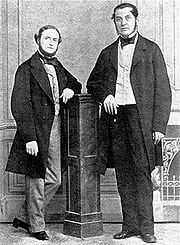Gustav Robert Kirchhoff
Gustav Robert Kirchhoff (12 March 1824 – 17 October 1887) was a German physicist who contributed to the fundamental understanding of electrical circuits, spectroscopy, and the emission of black-body radiation by heated objects. He coined the term “black body” radiation in 1862, and two sets of independent concepts in both circuit theory and thermal emission are named “Kirchhoff’s laws” after him. The Bunsen-Kirchhoff Award for spectroscopy is named after him and his colleague, Robert Bunsen.
Life and Work
Gustav Kirchhoff was born in Königsberg, East Prussia, the son of Friedrich Kirchhoff, a lawyer, and Johanna Henriette Wittke. He graduated from the Albertus University of Königsberg in 1847 where he attended the mathematico-physical seminar directed by Franz Ernst Neumann and Friedrich Julius Richelot. He married Clara Richelot, the daughter of his mathematics professor Richelot. In the same year, they moved to Berlin, where he stayed until he received a professorship at Breslau.

In 1862 he was awarded the Rumford Medal for his researches on the fixed lines of the solar spectrum, and on the inversion of the bright lines in the spectra of artificial light.Kirchhoff formulated his circuit laws, which are now ubiquitous in electrical engineering, in 1845, while still a student. He completed this study as a seminar exercise; it later became his doctoral dissertation. He proposed his law of thermal radiation in 1859, and gave a proof in 1861. He was called to the University of Heidelberg in 1854, where he collaborated in spectroscopic work with Robert Bunsen. Together Kirchhoff and Bunsen discovered caesium and rubidium in 1861. At Heidelberg he ran a mathematico-physical seminar, modelled on Neumann’s, with the mathematician Leo Koenigsberger. Among those who attended this seminar were Arthur Schuster and Sofia Kovalevskaya. In 1875 Kirchhoff accepted the first chair specifically dedicated to theoretical physics at Berlin.
He contributed greatly to the field of spectroscopy by formalizing three laws that describe the spectral composition of light emitted by incandescent objects, building substantially on the discoveries of David Alter and Anders Jonas Angstrom.
Kirchhoff died in 1887, and was buried in the St Matthäus Kirchhof Cemetery in Schöneberg, Berlin.
Kirchhoff’s Three Laws of Spectroscopy
- A hot solid object produces light with a continuous spectrum.
- A hot tenuous gas produces light with spectral lines at discrete wavelengths (i.e. specific colors) which depend on the energy levels of the atoms in the gas.
- A hot solid object surrounded by a cool tenuous gas (i.e. cooler than the hot object) produces light with an almost continuous spectrum which has gaps at discrete wavelengths depending on the energy levels of the atoms in the gas.
Kirchhoff did not know about the existence of energy levels in atoms. The existence of discrete spectral lines was later explained by the Bohr model of the atom, which helped lead to quantum mechanics.
For more information please call us: 1-409-861-0788 or toll-free at 1-866-861-0788.

